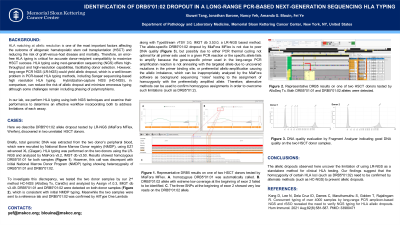Back

Identification of DRB5*01:02 dropout in a long-range PCR-based next-generation sequencing HLA typing
(P719) Identification of DRB5*01
Location: Platinum Ballroom

Poster Presenter(s)
Body: HLA matching at allelic resolution is one of the most important factors affecting the outcome of allogeneic hematopoietic stem cell transplantation (HSCT) and reducing the risk of graft-versus-host disease and mortality. Therefore, an error-free HLA typing is critical for accurate donor-recipient compatibility to maximize HSCT success. HLA typing using next-generation sequencing (NGS) offers high-throughput and high-resolution capabilities, facilitating donor selection. However, long-range PCR NGS (LR-NGS) could yield allelic dropout. Hybridization-capture NGS (HC-NGS), in comparison, can reduce the risk of allelic dropout and minimize erroneous typing although some challenges remain including phasing of polymorphisms. In our lab, we perform HLA typing using both NGS techniques.
Here we describe DRB5*01:02 allele dropout tested by LR-NGS (MiaFora MFlex, Werfen), discovered in two unrelated HSCT donors. HLA typing was performed on the two donors using the LR-NGS and analyzed by MiaFora v5.2, IMGT db v3.50. Results showed homozygous DRB5*01:01 for both samples (Figure 1). However, this call was discrepant with initial National Marrow Donor Program (NMDP) typing showing heterozygosity of DRB5*01:01 and DRB5*01:02. To investigate this discrepancy, we tested the two donor samples by our 2nd method HC-NGS (AlloSeq Tx, CareDx), and DRB5*01:01 and DRB5*01:02 were detected on both samples (Figure 2), which is consistent with initial NMDP typing. Meanwhile the two samples were sent to a reference lab and DRB5*01:02 was confirmed by AllType One Lambda, a LR-NGS based method. The allele-specific DRB5*01:02 dropout by MiaFora MFlex is possibly due to either PCR thermal cycling not optimal for all primer sets used in a given PCR reaction or preferential allelic-amplification causing the allelic imbalance, which can be inappropriately analyzed by the MiaFora software as background sequencing ‘‘noise” leading to the assignment of homozygosity with the preferentially amplified allele.
Conclusion: The allelic dropouts observed here uncover the limitation of using LR-NGS as a standalone method for clinical HLA testing. Our findings suggest that the homozygosity of certain HLA loci (such as DRB5*01:02) need to be confirmed by alternate methods (such as HC-NGS) to prevent allelic dropouts.
Here we describe DRB5*01:02 allele dropout tested by LR-NGS (MiaFora MFlex, Werfen), discovered in two unrelated HSCT donors. HLA typing was performed on the two donors using the LR-NGS and analyzed by MiaFora v5.2, IMGT db v3.50. Results showed homozygous DRB5*01:01 for both samples (Figure 1). However, this call was discrepant with initial National Marrow Donor Program (NMDP) typing showing heterozygosity of DRB5*01:01 and DRB5*01:02. To investigate this discrepancy, we tested the two donor samples by our 2nd method HC-NGS (AlloSeq Tx, CareDx), and DRB5*01:01 and DRB5*01:02 were detected on both samples (Figure 2), which is consistent with initial NMDP typing. Meanwhile the two samples were sent to a reference lab and DRB5*01:02 was confirmed by AllType One Lambda, a LR-NGS based method. The allele-specific DRB5*01:02 dropout by MiaFora MFlex is possibly due to either PCR thermal cycling not optimal for all primer sets used in a given PCR reaction or preferential allelic-amplification causing the allelic imbalance, which can be inappropriately analyzed by the MiaFora software as background sequencing ‘‘noise” leading to the assignment of homozygosity with the preferentially amplified allele.
Conclusion: The allelic dropouts observed here uncover the limitation of using LR-NGS as a standalone method for clinical HLA testing. Our findings suggest that the homozygosity of certain HLA loci (such as DRB5*01:02) need to be confirmed by alternate methods (such as HC-NGS) to prevent allelic dropouts.

